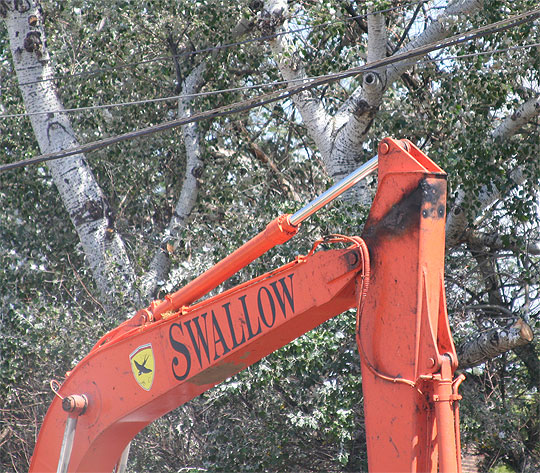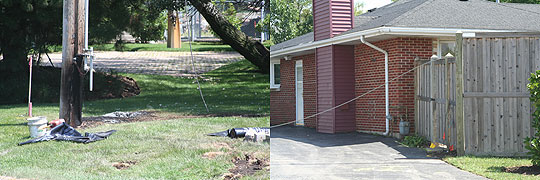A backhoe operator severed an overhead power line, which fell in a wet trench and electrocuted a construction worker Tuesday about 12:30 p.m. The accident occurred on the Wilke Road curve, just south of Palatine Road near the Route 53 overpass [MAP/SAT]. The worker, Roberto Lazano, 32, of Summit was transported to Northwest Community Hospital where he was pronounced dead.
UPDATE:
The man killed was identified as Roberto Lazano, 32, of the block of 6000 South 75th Avenue, Summit, according to the Cook County medical examiner’s office.

Charring at the joint of the articulated arm of a backhoe that hit an overhead powerline Tuesday.
At the scene it appeared the backhoe hit the overhead line at the joint of the articulated arm of the backhoe because charring was visible at the joint. The power line was severed. On the north side the severed line was arcing on the ground and pole. On the south side the severed line was draped over a backyard fence of a residence on Wilke Road.

Severed line on the north side of the scene, charring the ground and pole (left) and a severed line on the south side (right) draped over the fence of a nearby residence about 30 yards from the power line contact.

Charred pole and ground just north of the scene where a backhoe operator struck an overhead powerline.

Trench where construction workers were installing pipe for fire hydrants.
Trucks and operators from Swallow Sewer and Water Construction Company of Downers Grove were the apparent construction crews and equipment working at the construction site.
ComEd had several line trucks and supervisors on the scene after the accident. The power feed to the area was disconnected after the accident.
Workers that operate or work near backhoes face risk of injuries and death every day. A National Institute for Occupational Safety and Health (NIOSH) review of the Bureau of Labor Statistics (BLS) Census of Fatal Occupational Injuries (CFOI) data identified 346 deaths associated with excavators or backhoe loaders during 1992–2000 [NIOSH 2002]. Review of these data and of NIOSH Fatality Assessment and Control Evaluation (FACE) cases [NIOSH 2000, 2001] suggests two common causes of injury: (1) being struck by the moving machine, swinging booms, or other machine components; or (2) being struck by quick-disconnect excavator buckets that unexpectedly detach from the excavator stick. Other leading causes of fatalities are rollovers, electrocutions, and slides into trenches after cave-ins.
CDC/NIOSH (Centers for Disease Control and National Institute of Occupational Safety and Health advise as part of a construction site setup to “avoid working near overhead power lines. If you must work near them, develop a plan to avoid contact and to follow OSHA regulations for minimum clearance [29 CFR 1926.550(a)(15)].”
The rules in 29 CFR 1926.550(a)(15) are summarized as follows:
The OSHA regulations are summarized as follows:
Employers shall ensure that overhead power lines are deenergized or
separated from the crane and its load by implementing one or more of
the following procedures: -Deenergize and visibly ground electrical
distribution and transmission lines [29 CFR 1910.333(c)(3); 29 CFR
1926.550(a)(15)] -Use independent insulated barriers to prevent
physical contact with the power lines [29 CFR 1910.333(c)(3); 29 CFR
1926. 550(a)(15)] -Maintain minimum clearance between energized power
lines and the crane and its load [29 CFR 1910.333 (c)(3)(iii); 29 CFR
1926.550(a)(15)(i), (ii), (iii)].
Where it is difficult for the crane operator to maintain clearance
by visual means, a person shall be designated to observe the
clearance between the energized power lines and the crane and its
load [29 CFR 1926.550 (a)(15)(iv)].
The use of cagetype boom guards, insulating links, or proximity
warning devices shall not alter the need to follow required
precautions [29 CFR 1926.550 (a)(15)(v)]. These devices are not a
substitute for deenergizing and grounding lines or maintaining safe
line clearances.
The American National Standards Institute (ANSI) has published a
standard for mobile and locomotive cranes that includes operation
near overhead power lines [ANSI 1994]. This consensus standard
(B30.5-1994) contains guidelines for preventing contact between
cranes and electrical energy. The standard addresses the following
issues:
Considering any overhead wire to be energized unless and until the
person owning the line or the utility authorities verify that the
line is not energized
Deenergizing power lines before work begins, erecting insulated
barriers to prevent physical contact with the energized lines, or
maintaining safe clearance between the energized lines and boomed
equipment
Limitations of cagetype boom guards, insulating links, and
proximity warning devices
Notifying line owners before work is performed near power lines
Posting warnings on cranes cautioning the operators to maintain
safe clearance between energized power lines and their equipment.
Details from 29 CFR 1926.550(a)(15)
1926.550(a)(15) Link to documents referencing regulations
Except where electrical distribution and transmission lines have been deenergized and visibly grounded at point of work or where insulating barriers, not a part of or an attachment to the equipment or machinery, have been erected to prevent physical contact with the lines, equipment or machines shall be operated proximate to power lines only in accordance with the following:
1926.550(a)(15)(i) Link to documents referencing regulations
For lines rated 50 kV. or below, minimum clearance between the lines and any part of the crane or load shall be 10 feet;
1926.550(a)(15)(ii)
For lines rated over 50 kV., minimum clearance between the lines and any part of the crane or load shall be 10 feet plus 0.4 inch for each 1 kV. over 50 kV., or twice the length of the line insulator, but never less than 10 feet;
1926.550(a)(15)(iii)
In transit with no load and boom lowered, the equipment clearance shall be a minimum of 4 feet for voltages less than 50 kV., and 10 feet for voltages over 50 kV., up to and including 345 kV., and 16 feet for voltages up to and including 750 kV.
1926.550(a)(15)(iv)
A person shall be designated to observe clearance of the equipment and give timely warning for all operations where it is difficult for the operator to maintain the desired clearance by visual means;
1926.550(a)(15)(v)
Cage-type boom guards, insulating links, or proximity warning devices may be used on cranes, but the use of such devices shall not alter the requirements of any other regulation of this part even if such device is required by law or regulation;
1926.550(a)(15)(vi)
Any overhead wire shall be considered to be an energized line unless and until the person owning such line or the electrical utility authorities indicate that it is not an energized line and it has been visibly grounded;
1926.550(a)(15)(vii)
Prior to work near transmitter towers where an electrical charge can be induced in the equipment or materials being handled, the transmitter shall be de-energized or tests shall be made to determine if electrical charge is induced on the crane. The following precautions shall be taken when necessary to dissipate induced voltages:
1926.550(a)(15)(vii)(a)
The equipment shall be provided with an electrical ground directly to the upper rotating structure supporting the boom; and
1926.550(a)(15)(vii)(b)
Ground jumper cables shall be attached to materials being handled by boom equipment when electrical charge is induced while working near energized transmitters. Crews shall be provided with nonconductive poles having large alligator clips or other similar protection to attach the ground cable to the load.
1926.550(a)(15)(vii)(c)
Combustible and flammable materials shall be removed from the immediate area prior to operations.
More information …
CDC Publication No. 2004-107 Preventing Injuries When Working with Hydraulic Excavators ad Backhoe Loaders.
U.S. Department of Labor Occupational Safety & Health Administration
Regulations (Standards – 29 CFR)
Cranes and derricks – 1926.550 — look for 1926.550(a)(15)
— mb


 Amazon Best Sellers in Audible Books
Amazon Best Sellers in Audible Books